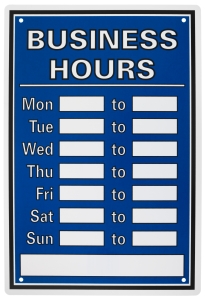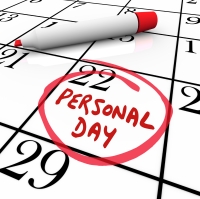by Katie Brazerol
Having clear, concise policies and procedures for your child care setting will support your business and help you avoid many potential problems and conflicts. Offering a handbook will help parents understand what to expect while their children are in your care. Having set policies and procedures in place will also make it easier for you to stand by your decisions.
 Although most providers set up some type of policy handbook before beginning child care, you may find that you need to add or change policies periodically. Choose a certain time of year to update information, and be sure to have parents sign new contracts to acknowledge and accept any changes.
Although most providers set up some type of policy handbook before beginning child care, you may find that you need to add or change policies periodically. Choose a certain time of year to update information, and be sure to have parents sign new contracts to acknowledge and accept any changes.
Listed below are some topics you may wish to include in your handbook. Most states require you to have written policies and procedures, so check with your local child care licensing agency for specific requirements. You can find a licensing information and contacts for your state here.
Admission
When a family shows interest in your child care, schedule an interview. It is important for you and the family to see whether the child would be a good fit. Once you and the family have agreed that your setting is a good fit, you may find it helpful to require a holding fee or deposit to hold the spot until the designated starting date. The holding fee/deposit can count as part of either the first or last payment. Many providers prefer to use the fee as the last payment in order to avoid abrupt exits with no pay.
Hours
 Setting hours for your child care might seem fairly straightforward, but many child care professionals can attest to the fact that families don’t always follow them. To ensure your hours are enforced rather than considered a loose guideline, create ways to clearly mark opening and closing time. Use a sign that can be flipped from Open to Closed or turn on an outside light to indicate that you are open. Keep your setting doors locked until opening time. Set up a late pick-up fee to discourage late pick-ups. Of course, emergencies and extenuating circumstances do happen, so you can always be flexible. You may decide to give a warning the first time a late pick-up occurs.
Setting hours for your child care might seem fairly straightforward, but many child care professionals can attest to the fact that families don’t always follow them. To ensure your hours are enforced rather than considered a loose guideline, create ways to clearly mark opening and closing time. Use a sign that can be flipped from Open to Closed or turn on an outside light to indicate that you are open. Keep your setting doors locked until opening time. Set up a late pick-up fee to discourage late pick-ups. Of course, emergencies and extenuating circumstances do happen, so you can always be flexible. You may decide to give a warning the first time a late pick-up occurs.
Payments
Set a schedule for payments and stick to it. If parents aren’t required to pay by a certain time, you might find yourself not getting paid at all. Many providers choose to require payment up front. This avoids situations involving abrupt exits with payments past due.
Create a payment date and decide whether you will allow a grace period. Once payment is considered late, you may wish to require a late payment fee. List this fee in your handbook, and specifically discuss the fee during the first interview and again when the child begins attending. You may find it only takes one or two late payment fees before a family consistently pays on time!
Vacation/Time Off
All child care professionals deserve time off. If you are the only staff member in your setting, set up a schedule of vacation or personal time off. You must decide if this time off will be paid or unpaid. If you have the opportunity to provide backup care, be sure to provide the name of your backup staff members to your  families. All staff, including backup caregivers, should have thorough background checks before providing care. Check with your local child care licensing agency for specific requirements.
families. All staff, including backup caregivers, should have thorough background checks before providing care. Check with your local child care licensing agency for specific requirements.
Many children may be gone at times throughout the year for personal family reasons. You will need to decide if these days will be paid or unpaid by the family. Some providers charge for 52 weeks a year no matter what, while others factor in vacation time for themselves and the families. Decide how you would like to handle time off, and clearly state your intentions in your handbook.
Activities/Curriculum
Not all settings are created equal. If you provide a specific curriculum, mention it in your handbook. Provide a web site address, if available, so families may browse the curriculum information in their free time. Mention whether or not you provide field trips, special visitors, or other unique activities.
Celebrations
Be up front with families about which (if any) holidays you celebrate, including birthday celebrations. Talk about how you celebrate, and consider inviting parents to provide suggestions about holidays that are special to their families. If you choose not to celebrate holidays, explain this in your handbook.
Belongings
Create a list of items that are the families’ responsibilities. Do they need to provide bedding, diapers, wipes, or diaper rash medication? Many preschoolers have  accidents. List items of extra clothing you would like to have on hand for the children. Will you be washing soiled clothes? Explain your procedure for soiled clothing, such as placing the item(s) in a plastic bag to be taken home to be washed. Also, will you allow toys, pacifiers, sippy cups, blankets, and stuffed animals from home? Be specific about what is allowed in the play area and nap/rest area.
accidents. List items of extra clothing you would like to have on hand for the children. Will you be washing soiled clothes? Explain your procedure for soiled clothing, such as placing the item(s) in a plastic bag to be taken home to be washed. Also, will you allow toys, pacifiers, sippy cups, blankets, and stuffed animals from home? Be specific about what is allowed in the play area and nap/rest area.
Pets
Most child care licensing agencies have specific guidelines for pets and child care. Follow guidelines set by your local agency. It is a good idea to list any pets that will reside in your setting. This will alert families who may have allergies to be aware of the types of pets present. If you choose to get a new pet, it is a good idea to let families in your care know ahead of time in case they wish to find an alternative setting.
Discipline
Not all families discipline the same way at home, but most child care licensing agencies require child cares to discipline in a consistent manner. List developmentally appropriate disciplinary actions, such as redirection, removal from the situation, or one-on-one time in a quiet space. Have a procedure to address excessive behavioral issues. It may be necessary to have a policy in place for purposely damaged items.
Emergencies
 Emergencies can strike all areas of the country. Have a disaster plan set up and clearly marked in your setting. Go over this plan with the children and families regularly. Create a meeting place outside your setting in case of evacuation, and also determine a nearby setting where parents can expect to find you in the case of neighborhood evacuation. You will find it beneficial to have a list of family phone numbers available at all times. (Be sure to update it regularly.) Many providers choose to have an emergency box that includes flashlights, batteries, nonperishable food items, bottled water, a first aid kit, and other safety materials that can be carried with your group if you need to leave your setting.
Emergencies can strike all areas of the country. Have a disaster plan set up and clearly marked in your setting. Go over this plan with the children and families regularly. Create a meeting place outside your setting in case of evacuation, and also determine a nearby setting where parents can expect to find you in the case of neighborhood evacuation. You will find it beneficial to have a list of family phone numbers available at all times. (Be sure to update it regularly.) Many providers choose to have an emergency box that includes flashlights, batteries, nonperishable food items, bottled water, a first aid kit, and other safety materials that can be carried with your group if you need to leave your setting.
Health Care
Contagious illnesses spread quickly among young children. Be clear about illnesses that will require absence from child care. Families may grumble when they get the call to come get their child, but they will be thankful to know that other sick children will not be in your care either. List specific illnesses that require time away from child care, such as vomiting, diarrhea, chicken pox, measles, pink eye, etc.
Some illnesses may fall under a gray area. A child who is teething might be irritable with a low-grade fever, but not be required to go home. A child with a bad cold might not have a fever, but still show signs that he is miserable. Having set policies on how you handle these situations will help families plan for alternative care, if needed.
You may also want to address how medications will be handled in your setting. Are you comfortable dispensing medicine (prescription and/or nonprescription) to children? State clearly the types of medicines you are willing to give and how they should be labeled. State licensing agencies may require that you offer a form for families to complete when they need you to administer medicine. Similar forms are often used for permission to apply sunscreen, lip balm, and lotion.
Finally, you may want to describe handwashing procedures. When will children wash their hands? Would you like families to wash their children’s hands upon arrival in your setting? Consider explaining these guidelines in advance.
Transportation
In the event you transport children from your setting in a motor vehicle, you must provide age-appropriate child seat restraints. Be sure the vehicle is covered under your insurance in case of an accident. Many providers choose to have families sign permission slips for transportation. If you choose not to provide transportation, be sure to mention it in your handbook.
Meals
Specify which meals or snacks you plan to provide in your child care, and note the times they will be served. You will not want to put breakfast items away only  to drag them out again 45 minutes later when a family arrives late! If a family plans to be gone over a meal or snack time, notify them whether or not it is their responsibility to make sure their child is fed.
to drag them out again 45 minutes later when a family arrives late! If a family plans to be gone over a meal or snack time, notify them whether or not it is their responsibility to make sure their child is fed.
Be sure to know about any food allergies children may have before they start in your child care. You may request that families supply food for children with highly specialized diets.
Many families have specific ideas about which foods are appropriate for their children. If you qualify for a federal food program, consider joining one. This will ensure that you are providing a variety of nutritious meals and snacks. To find out more about the Child Nutrition Programs available in your state, go to fns.usda.gov/cnd/Contacts/StateDirectory.
Termination
Unfortunately, not all families and settings are a good fit. Have a strategy in place for necessary termination. If a family plans to leave your setting, decide on a specific amount of time for giving notice. This will allow you time to fill the spot. If you have decided to terminate care, a courtesy of at least two weeks is often given. If possible, keep open communication between yourself and the family to ease the exit transition. Make sure families understand that noncompliance with any written guidelines in your policies and procedures can result in immediate termination. Your handbook is a valuable resource in showing whether or not the guidelines have been met.
Some situations result in unexpected termination, such as sudden job loss, illness, and family death. As the business owner, you may need to decide if notice is required. It may be best to state that you reserve the right to determine necessary action regarding specific circumstances.
Remember, a well-written handbook of policies and procedures can:
- Ensure understanding and agreement between the staff and families.
- Establish professional and effective practices.
- Provide consistency among staff and families.
- Help families to familiarize themselves with your service.
Additional Resources
Back to blog listing